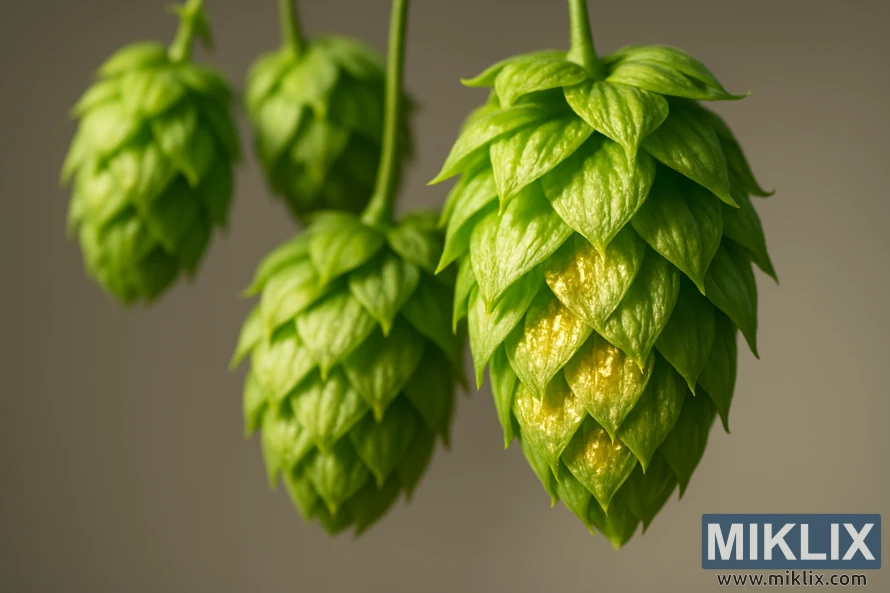Image: Fresh Hop Cones Detail
Published: July 27, 2025 at 7:02:30 PM UTC
Last updated: September 27, 2025 at 12:09:25 PM UTC
Detailed close-up of hop cones highlighting green leaves and golden lupulin glands for assessing beer quality.
In this striking close-up, several fresh hop cones are suspended in a manner that draws the eye directly to their intricate natural design. Each cone is composed of overlapping bracts, their delicate green leaves layered like scales, forming the familiar conical shape that has become an emblem of brewing. The surface glistens faintly under bright, directional lighting, which enhances the sharpness of each fold and edge, creating a sense of dimensionality and texture so tangible one can almost feel the papery dryness of the outer bracts beneath the fingertips. The careful illumination also reveals the subtle variations of green across the cones, from lighter lime tones along the edges to deeper emerald hues at the base, reinforcing their vitality and freshness.
At the heart of the composition lies a cone partially opened by the photographer’s focus, unveiling the golden lupulin glands nestled within. This detail becomes the central point of fascination, a glowing core of resinous oils that is the true treasure of the hop plant. The glands shimmer faintly under the light, their granular texture providing a stark contrast to the smoothness of the surrounding bracts. The warm, golden color of the lupulin seems almost luminous against the cooler greens, symbolizing the potency and aromatic richness these tiny glands hold. For brewers, this is the defining feature, the essence that imparts bitterness, aroma, and complex flavor to beer, and the image captures that significance with scientific precision and artistic reverence.
The background has been kept neutral and slightly blurred, a soft wash of muted tones that eliminates distraction and ensures the hops remain the sole subject of attention. This minimal backdrop not only emphasizes the vivid colors and complex structures of the cones but also creates an almost clinical environment, reminiscent of how hops might be assessed in a lab or during harvest quality checks. The simplicity of the background makes the scene feel timeless, bridging the gap between agricultural tradition and scientific evaluation, allowing the viewer to appreciate hops both as a crop and as a vital brewing ingredient.
There is an almost sculptural quality to the arrangement, as the cones hang gracefully, their stems disappearing upward beyond the frame. Their orientation suggests both natural growth and careful selection, as though they were plucked at the perfect moment of ripeness. The cones in the foreground command sharp attention, while those in the back softly blur into abstraction, reinforcing depth and drawing the viewer’s gaze toward the highlighted lupulin. This layered composition mirrors the very structure of the hops themselves—outer bracts protecting the golden core—creating a subtle visual metaphor for nature’s design and the brewer’s discovery.
The overall atmosphere of the image is one of appreciation and examination. The play of light and shadow invites prolonged study, encouraging the viewer to admire not only the aesthetic qualities of the hops but also their functional importance. It is a reminder that brewing, though often celebrated for its conviviality and creativity, is grounded in such moments of raw material scrutiny. By focusing on these cones in such exacting detail, the photograph transforms them from simple plant matter into symbols of craftsmanship, chemistry, and tradition. It highlights the fine balance of fragility and potency contained in each hop cone, underscoring why they remain indispensable in the art of brewing.
The image is related to: Hops in Beer Brewing: Willow Creek

